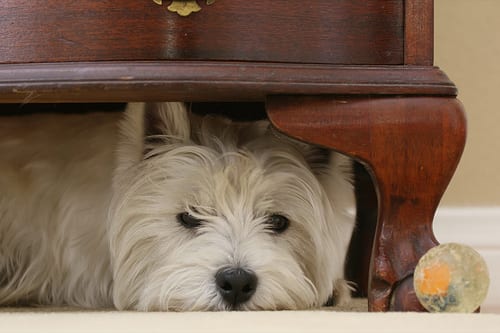Dogs are den animals. They derive a sense of security and safety from small places. What does that mean to you, the dog owner? There are places in your home that can become a place of possessiveness without you even knowing it. All dog owners, no matter what size of dog, should be aware of these zones. These areas in your home can become -over time- a place where a dog bite can occur. Children are often most at risk of being bitten. Dogs usually view small children as they would another dog. Toddlers often do not heed to a dogs’ warning of a growl. Then a snap can occur.
Fido Fact: 70% of all dog bites occur in the family home. Where are these danger zones in your home and how are they created? Allowing your dog to seek cover under furniture. These places are dining room tables, chairs, underneath beds, doorways, food bowls and car windows to name a few. These areas get created by your dog, in your daily life, over time. Dog toys and chew bones left lying around the house, yard gates/fences, dog bowls, doorways and car windows are troubled spots. Adding a child into the equation equals potential trouble. Here is the good news. This is totally preventable! Dog owner and parent awareness is the key. A trained dog looks to you for that sense of security. The following information is a good start to bring awareness of this preventable misunderstanding between dog and owner.
Paws For A Minute™ Quick Tips For Disarming Danger Zones!
1. Pick up all loose bones and toys around the house and yard. Occasionally, designate a chew bone time in a gated space for an hour or two. This can be done several times a day for mothers of toddlers. This provides your dog a safe place to enjoy a chew bone and socializes him to the noises and movements of your child safely. Doing this will prevent your dog from going underneath the furniture in the first place.
2. Beware of finicky eaters. Leaving food in a bowl can create territorial behavior and aggression over time. Always time feed your dog.
3. Toddler behavior can be a danger zone in itself. Allowing your child to push, bite and crawl around dogs can create a risky situation. Redirect this energy. Create a safe place for your dog for the hour that your child is on the loose.
4. If your dog is displaying any obsessive or possessive behavior, training and socialization are required. Knowing these danger zones is a great place to begin prevention.
Again, awareness of these danger spots in your home and your daily life are essential to create a safe environment for your family. Many dog owners look to their dog to see if the dog is going to be OK with a bone, child, etc. However, dogs are always looking to their owners to redirect them. Children are submissive to dogs and dogs see them as another animal. The above tips arm dog owners with the foresight of how dog bites can occur, even from the nicest dogs. Pets, as they mature, can be set in their ways, and its up to dog owners to guide and redirect them through obedience training with positive commands.
For more helpful tips, visit www.pawsforaminute.com.





